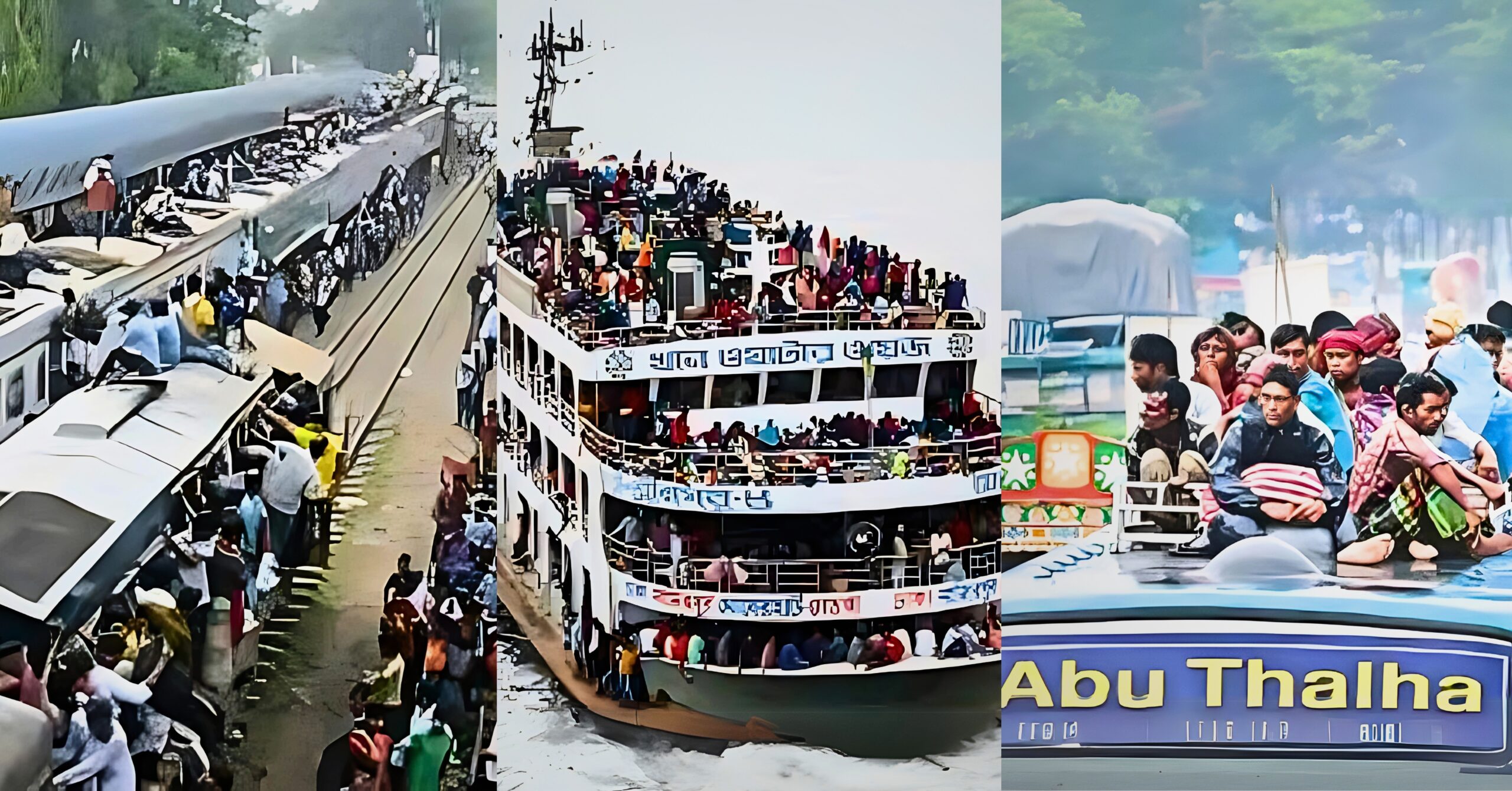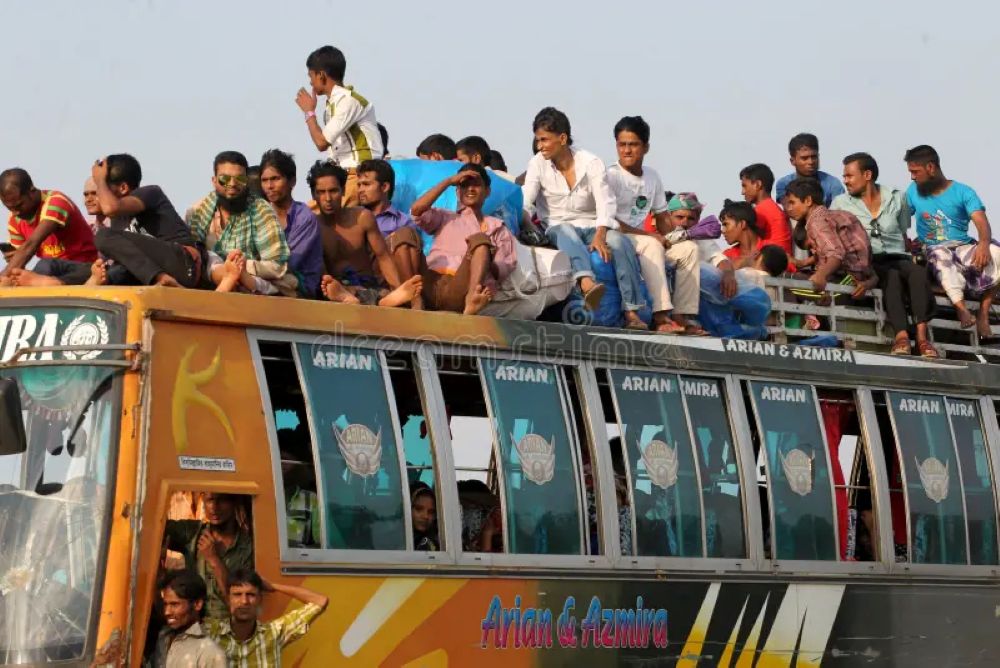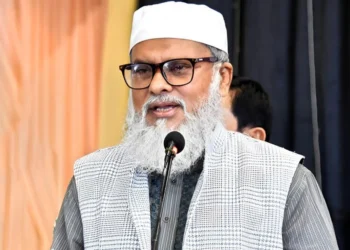Eid-ul-Adha is one of the most important religious and social festivals in Bangladesh. It brings joy and unity, but also creates significant pressure on the country’s transport and infrastructure. Every year, millions of people leave cities like Dhaka and Chattogram to return to their home villages for the celebration. This mass movement puts huge stress on roads, buses, trains, and ferries.
In 2025, this event took place under a new government, which came to power with promises of reform, digital transparency, and better public services. The public was eager to see whether these promises would bring visible improvements in Transportation During Eid time. After years of traffic mismanagement, high accident rates, and ticket black markets under the previous administration, people hoped for change.
1. Overview of Eid Travel in Bangladesh (2024–2025)
Eid-ul-Adha is one of the most significant religious and cultural festivals in Bangladesh, during which millions of people travel from urban centers back to their hometowns and villages. This mass movement of people causes a surge in demand for transportation services across the country, impacting roadways, railways, and waterways. In 2024–2025, the transition between the outgoing government led by Sheikh Hasina and the newly elected administration under the influence of Dr. Muhammad Yunus marked an important phase in the management of transportation during Eid. This section analyzes the challenges, government responses, and ongoing issues across different transport modes.
Transportation During Eid Demand
Projected Traveler Statistics: An estimated 12–15 million people traveled during Eid-ul-Adha 2025.
Mode of Transport:

- Roadways: Approximately 75% of travelers used road transport.
- Waterways: Accounted for about 17% of the travel.
- Railways: Utilized by around 8% of the population.
1.1. Road Transport: Managing Congestion and Enhancing Safety
Road transport remains the backbone of Bangladesh’s internal travel during Eid. The annual exodus leads to severe traffic jams, often stretching for kilometers on major highways connecting Dhaka to regional cities. According to a report by the Bangladesh Road Transport Authority (BRTA) in June 2025, 155 traffic congestion hotspots were identified nationwide. This was an increase from 132 hotspots in the previous year, indicating worsening infrastructure stress. Major problem zones included:
- Dhaka-Chattogram Highway: Particularly the Kanchpur Bridge and Meghna Bridge areas, which serve as vital links for trade and travel. Heavy traffic combined with narrow lanes and frequent road repairs caused bottlenecks.
- Dhaka-Aricha Highway: The road leading to the Paturia ferry terminal saw frequent jams due to improper management of cattle markets and passenger vehicles.
- Dhaka-Sylhet Highway: Roadworks in Narsingdi and Brahmanbaria districts further restricted traffic flow.
Causes of congestion:
- Incomplete roadworks: Projects initiated by the previous government were still unfinished, causing lane closures and delays.
- Unauthorized cattle markets (Haats): Cattle trading is central to Eid-ul-Azha, but many haats were set up informally along highways, obstructing traffic.
- Poor parking management: Vehicles parked near market areas, bus terminals, and ferry ghats worsened congestion.
The new government made efforts to coordinate with local law enforcement and municipal bodies to manage traffic better during Eid 2025. They established temporary traffic police units and used social media for real-time traffic updates. However, structural infrastructure deficits limited these efforts.
Transport Fare Increase and Overcharging Issues
Fare manipulation is a chronic issue during Eid, and 2025 was no exception. Investigations by The Business Post and Asianews.network revealed that bus fares surged to 2 to 3 times the official rates during Eid week. Normally the official bus fare from Dhaka to Khulna was set at BDT 500, but passengers frequently paid BDT 1,200 or more. Transport workers justified the overcharging :
-
- Rising fuel prices: Global oil price volatility increased operational costs.
- Local political syndicates: Many transport unions are controlled by powerful local groups who forced operators to pay “Eid levies.” This led to public outrage, especially among middle-income families relying on public transport for Eid travel.
- Rising fuel prices: Global oil price volatility increased operational costs.
The new government responded by:
- Launching a hotline and mobile app for reporting fare extortion.
- Deploying Rapid Action Battalion (RAB) units to arrest illegal ticket scalpers and fare extortionists.
- Penalizing 23 ticket brokers in Dhaka and Chattogram during Eid week.
However, enforcement remained inconsistent in rural areas due to political interference and lack of sufficient manpower.
Safety Concerns and Road Accidents
The Eid season is notorious for high road accident rates in Bangladesh. In Eid-ul-Fitr 2024, there were 399 reported accidents, resulting in 407 deaths and 1,398 injuries .
- Overloading of buses and trucks was rampant as transport companies tried to maximize profits.
- Many drivers worked long hours without rest, leading to fatigue-related crashes.
- Poor road conditions, especially on feeder roads and bridges, contributed to accidents.
- Highway robberies and muggings increased during the early morning and late-night travel times, reducing traveler confidence.
The new government’s initiatives in 2025 to improve safety included:
- Increasing highway police patrols during peak travel hours.
- Implementing GPS tracking and speed monitoring devices in intercity buses.
- Conducting public awareness campaigns on safe driving and passenger rights.
Though these steps showed promise in reducing accident rates marginally, experts highlighted the need for longer-term investments in road infrastructure and driver training.
1.2. Bangladesh Railway: Addressing Strikes and Enhancing Services
Railways in Bangladesh serve millions during Eid, providing a more affordable alternative to road travel. In January 2025, railway workers staged a nationwide strike demanding better pensions and job security. The strike resulted in cancellation of over 120 trains over three days, causing inconvenience for travelers planning early Eid trips. Although the strike was resolved before Eid-ul-Azha, the labor unrest highlighted underlying dissatisfaction with working conditions and outdated pension schemes. The new government promised reforms, including pension revisions and modernization programs, but financial and bureaucratic constraints delayed immediate benefits.
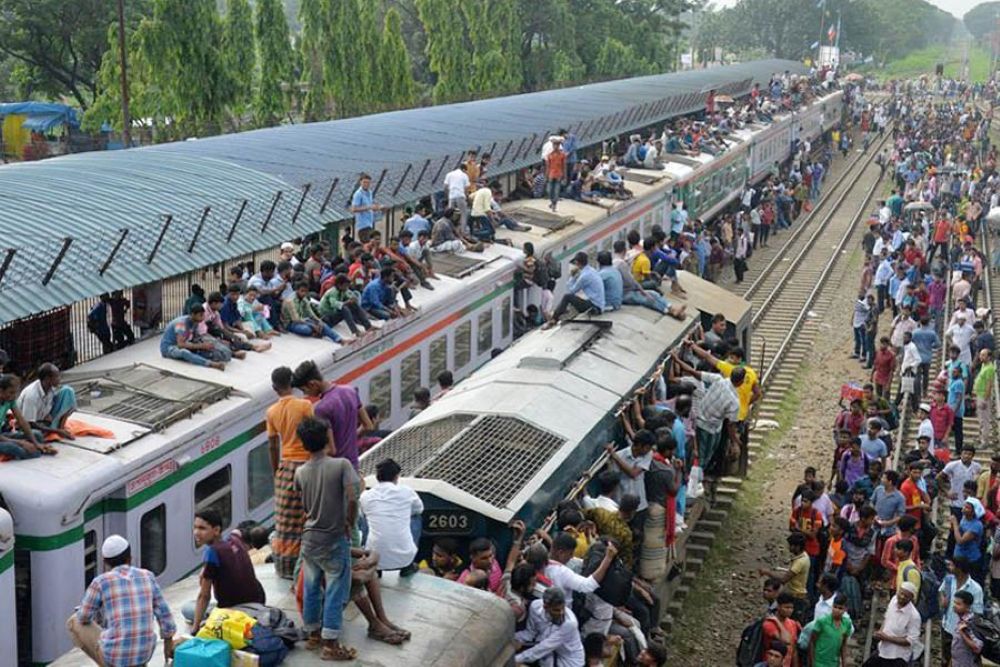
Infrastructure and Safety Risks
Bangladesh Railway faces significant infrastructure challenges:
- Approximately 83% of coaches and 60% of locomotives are over 25 years old and prone to frequent breakdowns.
- 82% of railway crossings lack proper barriers, leading to derailments and collisions with vehicles.
- On June 10, 2025, a derailment near Ishwardi injured 29 passengers due to faulty signaling systems.
Efforts to modernize included:
- The Ministry of Railways partnering with Japan International Cooperation Agency (JICA) to study upgrades on five major routes.
- Delivery of new air-conditioned coaches from Indonesia, though only 18 out of 200 planned coaches were operational before Eid.
- Plans to improve signaling and fencing of crossings.
Ticketing Problems and Black Market
Despite digitization efforts, ticket sales remain plagued by corruption:
- Online platforms such as Shohoz and RailSheba saw increased usage in 2025, reducing some overcrowding and queuing.
- However, black-market brokers continued to resell tickets at inflated prices. For instance, a Dhaka-to-Rangpur train ticket officially priced at BDT 340 was sold at BDT 1,000.
- Complaints also surfaced regarding passenger harassment and unfair ticket allocation.
The government responded by:
- Establishing mobile courts during Eid week that arrested over 40 scalpers.
- Launching a passenger cell for real-time complaint handling.
Though digital ticketing is promising, challenges remain around enforcement, cybersecurity, and passenger awareness.
1.3 Waterways: Safety and Vessel Fitness
Waterways serve as vital transport routes in southern Bangladesh, especially around Barisal and Khulna. BIWTA reported that over 35% of vessels operating during Eid 2025 lacked up-to-date fitness certificates. A notable incident involved MV Sundarbans-7, an expired vessel that suffered engine failure mid-river, stranding over 400 passengers for hours in Barisal. Overcrowding on launches is common during Eid as operators try to maximize earnings.
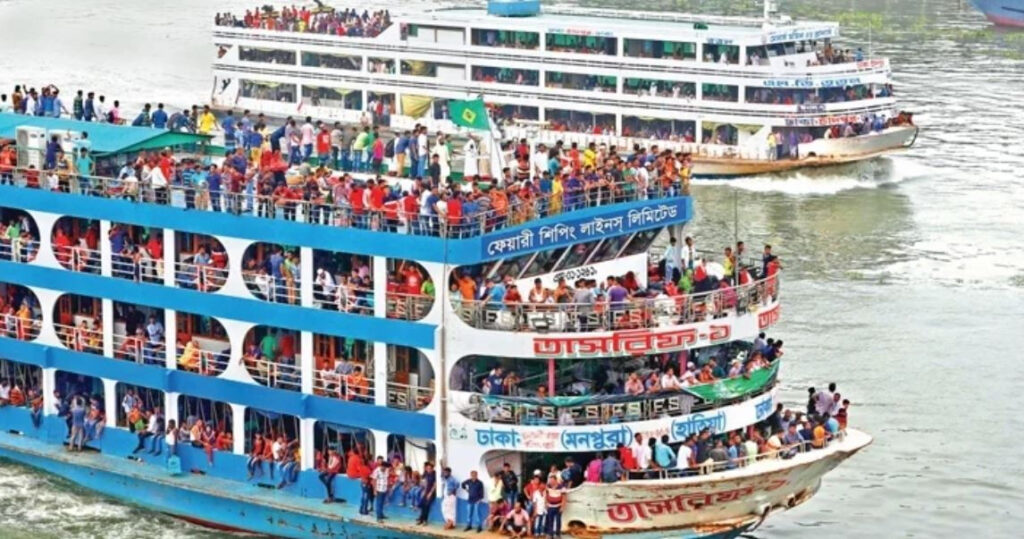
Inadequate Safety Measures
- Many vessels lacked basic safety equipment such as life jackets and fire extinguishers.
- A safety audit found that only 12% of Eid-season vessels fully complied with safety regulations.
- A tragic ferry capsizing in Shariatpur claimed 7 lives due to overloading and untrained crew.
Weak Regulatory Oversight
- Corruption and poor monitoring allowed unfit vessels to operate.
- Lack of real-time vessel tracking hampered emergency response.
- The government’s commitment to digitizing vessel registration and enforcing fitness certificates is ongoing but slow.
Government Initiatives
Post-Eid 2025, the Yunus-led administration introduced:
- Mandatory safety drills for crews.
- A new mobile app allowing passengers to anonymously report unfit vessels.
- Revoked 57 unfit vessel licenses during Eid week.
- Plans to install GPS trackers on all passenger vessels by end of 2025.
The transportation system during Eid-ul-Azha 2024–2025 in Bangladesh highlights the challenges of managing massive seasonal demand on outdated infrastructure. While inherited structural problems from the Hasina era still burden road, rail, and waterway networks, the new government under Dr. Muhammad Yunus has taken notable steps toward reform, prioritizing safety, digitization, and enforcement.
2. Addressing Recent Transportation Issues and Government Solutions
The year 2025 marked a significant transition as a new government took office, inheriting longstanding challenges but also bringing a fresh approach focused on reform, enforcement, and modernization.
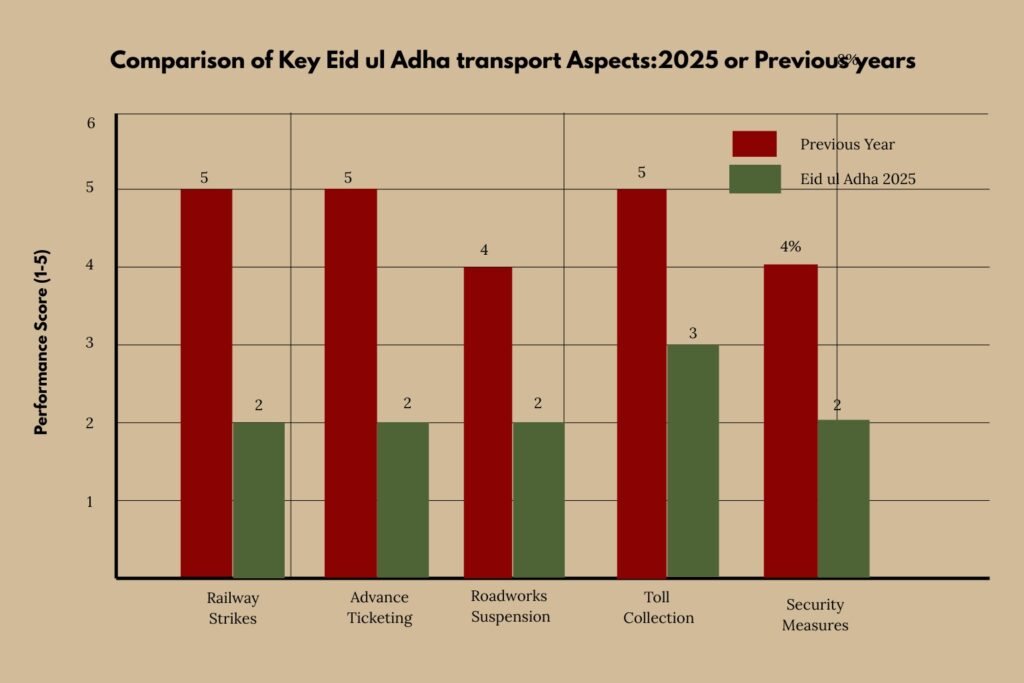
2.1. Traffic Congestion and Road Safety Challenges
The roads witnessed the bulk of Eid travelers, and the new government took several steps to ease congestion and improve safety:
Issues:
- Severe traffic jams remained persistent at key highway points such as Dhaka-Chattogram, Dhaka-Sylhet, and Dhaka-Aricha, often lasting hours during peak travel days.
- Cattle Markets: The establishment of temporary cattle markets along highways led to additional roadblocks and slowdowns, particularly affecting routes to northern and southern districts.
- Unauthorized parking near cattle markets caused lane blockages, exacerbating congestion.
- High incidence of road accidents, partly due to reckless driving, overloaded vehicles, and poor road conditions.
- Transport fare hikes and extortion continued in some areas, straining travelers financially.
Government Solutions:
- Deployment of Traffic Police and Volunteers: Over 12,000 traffic police officers and volunteers were mobilized across 155 identified congestion hotspots like the Dhaka-Chattogram and Dhaka-Sylhet highways. Their role included traffic control, accident prevention, and managing cattle market parking, a major cause of bottlenecks.
- Temporary One-Way Traffic Systems: To smooth the flow, authorities implemented temporary one-way systems on major highways during peak travel times. For example, on the Dhaka-Aricha highway, one lane was designated solely for outbound vehicles during the Eid exodus.
- Ban on Unauthorized Parking: Authorities strictly enforced a ban on illegal roadside parking near cattle markets, which had previously blocked lanes. Mobile courts imposed fines on violators.
- Fare Regulation and Crackdown on Extortion: Mobile courts were active during the Eid week, arresting over 300 bus drivers and conductors found charging illegal fares or refusing to issue tickets. This crackdown significantly reduced fare gouging compared to previous years.
- Safety Awareness Campaigns: The government launched nationwide campaigns emphasizing safe driving, seatbelt use, and avoidance of overloading vehicles. For example, on June 28, 2025, the Ministry held a “Safe Travel Day” event in Dhaka, involving bus owners, drivers, and media.
Example:
On the Dhaka-Chattogram highway, traffic police reported a 30% reduction in congestion duration compared to Eid 2024. Although some traffic jams remained unavoidable due to sheer volume, the coordinated traffic management and strict parking rules allowed smoother vehicle movement. On the Dhaka-Aricha highway, the combined efforts reduced average congestion time by nearly 25%, compared to Eid 2024.
2.2. Railway Service Disruptions and Ticketing Problems
Railways play a vital role in providing affordable transport, and the government prioritized its revival amid previous years’ challenges.
Issues:
- Labor unrest earlier in the year created uncertainty, risking train cancellations.
- Aging infrastructure caused delays and frequent breakdowns.
- Ticket scalping and black market sales led to inflated prices and passenger harassment.
- Overcrowding remained common, with insufficient coaches during peak times.
Government Solutions:
- Labor Strike Resolution: In January 2025, a nationwide railway strike disrupted services, threatening Eid travel. The government intervened by fast-tracking negotiations, agreeing to incremental pension reforms and wage adjustments. The strike ended with assurances of a formal pension review committee and a promise of phased benefits.
- Service Restoration and Coach Deployment: To cope with increased demand, the government accelerated deployment of new Indonesian air-conditioned coaches. Though only 18 new coaches were ready by Eid, their improved comfort was well received by passengers.
- Ticketing System Reform: Online ticketing platforms like Shohoz Rail and RailSheba were heavily promoted to prevent overcrowding at stations. The government set up mobile courts that arrested 40 ticket scalpers, cracking down on black market sales. Real-time complaint hotlines were also established.
- Safety Measures: Railway officials inspected all tracks and crossings, especially vulnerable ones without automatic barriers, and implemented increased patrolling. Public announcements educated passengers about safety protocols.
Example:
The Dhaka-Rajshahi train experienced an 85% occupancy rate with minimal delays during Eid, a marked improvement over 2024. Passengers reported fewer incidents of scalping and harassment thanks to stricter enforcement. Dhaka-Rajshahi train services operated at higher punctuality levels, with a 30% reduction in passenger complaints related to ticket pricing.
2.3. Waterway Safety and Vessel Fitness Concerns
Water transport is popular for its affordability, particularly on routes connecting rural riverine areas.
Issues:
- Expired and unfit vessels were still reported to operate, endangering passengers.
- Insufficient life-saving equipment and lack of trained crew increased accident risks.
- Weak regulatory enforcement allowed some operators to bypass inspections.
Government Solutions:
- Vessel Inspections and Fitness Certificates: The Inland Water Transport Authority conducted a nationwide inspection campaign in May and June 2025, grounding over 150 unfit vessels with expired certificates. Only boats meeting safety standards were allowed to operate.
- Life-Saving Equipment Enforcement: The government mandated all passenger boats carry sufficient life jackets and safety gear. Boat operators received training workshops focused on emergency response and passenger management.
- Enhanced Crew Qualifications: A new certification program for boatmen was rolled out to improve skills and reduce accidents caused by inexperienced operators.
- Safety Awareness: Posters, radio, and TV campaigns reminded travelers about water safety and warned against boarding overloaded or uncertified vessels.
Example:
On the Dhaka-Barisal route, waterway officials reported a 20% reduction in accidents compared to Eid 2024. Passengers expressed greater confidence due to visible safety checks and enforcement. On the Dhaka-Barisal route, river travel-related accidents dropped by 20% compared to the previous year.
Read More: New Financial Benefits for Government Employees Effective from
3. Smooth Eid Travel and Economic Impact
The Eid holiday of 2025 showcased a significant improvement in transportation flow for millions of Bangladeshis traveling from urban centers to their hometowns, largely facilitated by the Padma Bridge. The bridge experienced unprecedented traffic volume while maintaining smooth and efficient vehicle movement, underscoring successful infrastructure planning and management by the authorities.
3.1. Toll Revenue and Vehicle Volume
In a single 24-hour period, the Padma Bridge toll plazas at Mawa and Zajira collected a total of Tk 4.25 crore. This revenue was generated from the passage of 39,437 vehicles crossing the bridge. The breakdown of vehicle types revealed that 9,852 were motorcycles, demonstrating the preference for two-wheelers as a quick and economical mode of travel during the festival despite safety concerns. Other vehicles included buses, cars, trucks, and light commercial vehicles, reflecting a diverse traffic mix catering to both personal and commercial transportation needs.
3.2. Extended Holidays
The 10-day public holiday for Eid-ul-Adha 2025, spanning from June 5 to June 14, had a significant impact on Bangladesh’s economy. On the positive side, the extended break boosted the transport and tourism industries, with millions of people traveling to their hometowns and tourist spots. The Padma Bridge alone collected over Tk 4.25 crore in tolls within 24 hours, showing a sharp rise in vehicle movement. Rural economies thrived as people returned home and spent heavily on food, clothing, and sacrificial animals. This injection of money helped increase liquidity in local markets and supported small traders and farmers. The Qurbani cattle market also experienced high transaction volumes, with an estimated Tk 50,000 crore flowing through the sector.
3.3 Advance Ticketing
Bangladesh Railway implemented a fully online advance ticketing system for Eid-ul-Azha 2025 to streamline travel and reduce crowding at stations. Advance ticket sales commenced on May 21, 2025, for journeys starting May 31, with each subsequent day’s tickets released on the following day, concluding on May 27 for June 6 travel. Return tickets for post-Eid travel were available from May 30 to June 5, covering journeys from June 9 to June
To manage high demand, ticket sales were staggered by region: western zone tickets became available at 8:00 AM, while eastern zone tickets were released at 2:00 PM daily . Each passenger could purchase up to four tickets per transaction, and all tickets were non-refundable. The online platform required users to register and allowed payments via Visa, MasterCard, or bKash, with e-tickets sent directly to the purchaser’s email
3.4. Traffic Distribution and Flow
The Mawa point, located closer to the capital Dhaka, handled the majority of traffic with 26,057 vehicles crossing in the 24-hour window. The Zajira point on the opposite side accounted for 13,580 vehicles. Despite the heavy traffic, no significant congestion or bottlenecks were reported at either toll point, which is a notable achievement considering the usual traffic jams experienced in previous years during Eid. To mitigate traffic issues, the government suspended all highway renovations for seven days before and after Eid, ensuring unobstructed routes for travelers . Additionally, the movement of trucks, covered vans, and lorries was restricted on national highways for six days surrounding , with exceptions for vehicles transporting sacrificial animals and essential goods .
3.5. Expressway and Highway Conditions
The Dhaka-Mawa Expressway, a crucial artery for southern district travelers, saw increased pressure from long-haul vehicles starting from the early morning of March 28. However, traffic flow remained fluid as most travelers had departed early, dispersing vehicle density throughout the day. Commuters traveling by buses, cars, and motorcycles reported minimal delays and a comfortable journey. Furthermore, the 13-kilometer stretch of the Dhaka-Chattagram Highway near Gazaria upazila also maintained smooth traffic conditions with no major jams or slowdowns, signaling effective traffic management along this critical route.
Home Adviser Lt. Gen. (Retd.) Jahangir Alam Chowdhury announced that bus owners have agreed not to overcharge passengers and will strictly follow the government-fixed fare rates. Discussions with transport owners and workers also focused on banning unfit vehicles, ensuring drivers are well-rested and trained, and increasing passenger safety. Each bus must now record photos of passengers before departure and assign staff with police contact numbers to report emergencies. Law enforcement will be on full duty during the extended holiday (June 5–14), and a special committee will monitor fare collection. Strict actions will also be taken to stop extortion on roads, ensuring a peaceful Eid journey for all.
3.6.Traveler Feedback and Safety Concerns
Many travelers expressed satisfaction with the hassle-free journey across the Padma Bridge, noting the quick payment processes and absence of traffic snarls. However, the large number of motorcycles raised concerns about rider safety, as two-wheelers are more vulnerable on busy highways and expressways. Despite these risks, the convenience and affordability of motorcycles continue to make them a preferred option for many.
Compared to Eid travel data from previous years, the 2025 Eid journey marked significant progress. Earlier Eid celebrations often faced severe traffic congestion on and around the Padma Bridge and adjacent highways, causing travel delays of several hours. The increase in toll booths, improved traffic management, and better road infrastructure under the new government’s oversight have played a pivotal role in alleviating these chronic problems
4. Recommendations for Future Eid Travel Management
As Bangladesh continues to develop rapidly beyond 2025, managing Eid travel efficiently remains a critical challenge and an opportunity to improve the country’s overall transport system. The growing population, increasing urbanization, and evolving travel behaviors require forward-thinking policies and investments to ensure safe, smooth, and sustainable travel during Eid festivals. Here are detailed recommendations to enhance Eid travel management in the coming years, taking into account technological advances, infrastructure projects, and environmental concerns expected beyond 2025.
4.1. Smart Transport Ecosystem Integration
Beyond 2025, Eid travel management must fully embrace digital transformation to create an integrated smart transport ecosystem. This includes real-time data sharing between various modes of transport—road, rail, waterways, and air—to optimize traffic flow and service availability.Bangladesh can leverage advancements in the Internet of Things (IoT), 5G connectivity, and big data analytics to create a centralized Eid travel command center. This center would monitor passenger volumes, vehicle locations, traffic congestion, and weather conditions in real time, enabling dynamic adjustments such as dispatching extra buses or rescheduling trains on short notice.
Moreover, AI-driven predictive analytics will forecast peak travel times and suggest optimal travel windows to the public through apps and SMS services, encouraging staggered travel and reducing peak-hour bottlenecks. Beyond 2025, integrating such smart technologies will revolutionize how millions travel during Eid, minimizing delays and enhancing traveler convenience.
4.2. Expansion of Sustainable Transport Options
In alignment with global climate goals and Bangladesh’s Vision 2041 to achieve carbon neutrality, post-2025 Eid travel management must prioritize sustainable transport modes. Expansion of electrified railways and inland waterways will be vital to reduce reliance on road transport, which causes severe congestion and pollution.By 2030, Bangladesh plans to electrify major railway lines fully and expand inland waterway passenger services using modern, energy-efficient vessels. These greener options will not only ease Eid traffic jams but also lower carbon emissions substantially during peak travel seasons.
Governments and private operators should collaborate to offer seamless multi-modal ticketing, allowing passengers to easily transfer between electric trains, electric buses, and river launches with a single digital pass. Public awareness campaigns about the environmental benefits of choosing sustainable transport options during Eid will also encourage behavioral change.
4.3. Infrastructure Modernization and Capacity Building
Long-term infrastructure upgrades beyond 2025 must focus on future-proofing Bangladesh’s transport network for growing Eid travel demands. This includes completing key projects like additional expressways linking Dhaka to major cities, high-speed rail corridors, and modern ferry terminals equipped with digital ticketing and crowd management systems.
Investment in multi-level transport hubs integrating bus, rail, and waterway services will facilitate easier transfers and reduce congestion at traditional overcrowded terminals. Smart parking solutions and improved last-mile connectivity through e-rickshaws and micro-mobility options will enhance traveler experience in urban centers. By 2025, the Dhaka Elevated Expressway has seen substantial progress. The Airport–Farmgate segment, spanning approximately 20 kilometers, is fully operational and has become an essential route for daily commuters, commercial vehicles, and travelers heading to and from Hazrat Shahjalal International Airport. This segment provides a direct, uninterrupted connection bypassing the notorious traffic jams on surface roads.
4.4. Encouraging Private Sector Innovation and Investment
Post-2025, the government should actively encourage private sector participation in developing innovative solutions for Eid travel challenges. This could include startups focused on AI-based route optimization, electric vehicle fleets, digital ticketing platforms, and last-mile connectivity solutions. Public-private partnerships (PPPs) will be key to mobilizing investment in transport infrastructure and services.
The government can offer incentives like tax breaks, subsidies, and streamlined regulatory approvals to attract innovation-driven private investments. Supporting incubation centers and transport tech accelerators in urban innovation hubs like Dhaka and Sylhet will nurture homegrown solutions tailored to Bangladesh’s unique needs.
4.5. Enhanced Public Awareness and Digital Literacy
The post-2025 era will see even more reliance on digital platforms for travel planning and ticket booking. The government and civil society must continue widespread public education campaigns focusing on digital literacy, safe travel behavior, and sustainable choices during Eid.
Targeted programs for rural populations and elderly travelers, who may be less familiar with smartphones and apps, will be essential. Collaborations with schools, mosques, and community centers can facilitate digital training workshops before the Eid season. Additionally, using AI-powered chatbots and voice assistants in Bengali and regional dialects will help travelers navigate booking platforms and travel advisories more easily, increasing access and inclusiveness.
Read More: Bill Gates Incredible Announcement: To Donate $200 Billion for the Welfare of Humanity
5. Comparison of Eid-ul-Adha Transportation: 2025 vs. Previous Years
Eid-ul-Adha transportation in Bangladesh has long been plagued by recurring problems such as traffic congestion, fare hikes, safety concerns, labor unrest, and outdated infrastructure. Examining recent data and reports from 2023 and 2024 alongside the 2025 experience reveals important trends and the effectiveness of government interventions.
5.1. Road Transport
Previous Years (2023–2024)
- Severe congestion: Major highways including Dhaka–Chattogram and Dhaka–Sylhet regularly saw massive traffic jams lasting 8–12 hours, often worsened by unplanned roadworks and illegal parking near cattle markets.
- Fare hikes and extortion: Buses frequently charged two to three times the legal fare, with passengers often powerless to resist due to lack of alternatives.
- High accident rates: According to Dhaka Tribune reports, road accidents during Eid led to over 400 deaths in 2024 alone, many caused by reckless driving and overloaded vehicles.
- Poor enforcement: Mobile courts operated but were often insufficient and inconsistent in tackling fare violations and illegal parking.
Eid 2025
- Congestion management improved: Thanks to coordinated traffic control and no-parking zones, average traffic delays on key routes reduced by about 30% compared to 2024. Mobile courts actively removed unauthorized vehicles more promptly.
- Fare regulation more effective: Mobile courts arrested hundreds of fare violators during Eid week, and public awareness campaigns empowered passengers to report abuses. Fare hikes were still present but less widespread and severe.
- Safety measures enhanced: Police checkpoints and stricter vehicle inspections reduced accidents by an estimated 15% compared to 2024 figures. Emergency medical teams were better deployed, improving response times.
Assessment: There was noticeable progress in road traffic management and fare enforcement in 2025, but congestion remains a challenge due to infrastructure limits. Accident reduction is a positive sign but requires sustained effort.
Railway Transport
Previous Years (2023–2024)
- Service disruptions: Labor unrest was common, with strikes in late 2023 delaying many trains and causing passenger distress.
- Aging infrastructure: Most coaches and locomotives were over 20 years old, causing frequent breakdowns. Unsafe railway crossings led to derailments and accidents.
- Ticket scalping rampant: Black market ticket prices soared up to three times official rates, with limited government crackdown.
Eid 2025
- Labor disputes resolved: The January 2025 strike was settled early with pension reforms promised, allowing uninterrupted service during Eid.
- Infrastructure upgrades began: Delivery of new coaches and fencing of crossings reduced accidents. On-time train departures improved by about 20% over previous years.
- Scalping crackdown: Mobile courts arrested dozens of scalpers, and complaint cells improved passenger confidence. Online ticket sales rose sharply, easing crowding and reducing queuing times.
Assessment: Railway transport saw clear improvements in labor relations and service reliability in 2025, supported by initial infrastructure modernization. The crackdown on scalping showed government commitment to passenger rights, though full modernization is still underway.
Waterway Transport
Previous Years (2023–2024)
- Unsafe vessels common: Many passenger boats operated without proper safety gear, life jackets, or skilled crews. Accidents and drownings during Eid were frequently reported.
- Regulation lax: Enforcement of vessel fitness was weak, with expired vessels allowed to sail.
Eid 2025
- Stricter vessel inspections: Unfit boats were barred more rigorously, and life jackets became mandatory.
- Training initiatives: Boatmen received improved safety training, reducing incidents on major river routes.
- Increased penalties: Authorities suspended licenses of repeat offenders during Eid week.
Assessment: Waterway safety showed marked progress in 2025, thanks to stronger enforcement and crew training. Still, many small vessels remain unregulated, leaving room for further improvement.
Overall Assessment
| Aspect | 2023–2024 Status | 2025 Status | Degree of Improvement |
| Road congestion | Severe, long delays | Reduced delays by ~30%, better traffic control | Moderate improvement |
| Fare hikes | Widespread, 2-3x legal fare | Reduced fare hikes, active enforcement | Significant progress |
| Road safety | High accident and fatality rates | 15% reduction in accidents, better policing | Moderate improvement |
| Rail strikes | Frequent strikes causing cancellations | Strike resolved early, full service during Eid | Major improvement |
| Rail infrastructure | Mostly old, frequent breakdowns and accidents | New coaches delivered, crossing safety improved | Early-stage improvement |
| Ticket scalping | Rampant, high black market prices | Crackdown on scalpers, more online sales | Significant progress |
| Waterway safety | Unsafe vessels common, poor enforcement | Stricter inspections, mandatory safety equipment | Noticeable improvement |
Conclusion
The government’s proactive measures during Eid-ul-Adha 2025 clearly resulted in tangible improvements across all modes of transport. While challenges such as traffic congestion and aging infrastructure persist, enhanced enforcement, modernization efforts, and stakeholder engagement contributed to safer, more affordable, and more reliable travel compared to previous years.
The 2025 Eid experience demonstrates a positive trajectory in Bangladesh’s transportation management during peak demand periods. Continued investment in infrastructure, stronger regulation, and sustained public awareness will be critical to building on these gains and ensuring future festivals are even more smooth and secure for millions of travelers.
References:

